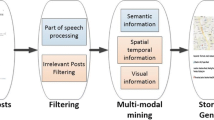Abstract
With the development of social networks, more and more people use social networks to publish and disseminate national security emergencies. In order to effectively control the spread and development of Chinese social network national security emergencies, we need to make an effective portrait of the emergencies. However, Chinese social network information has two research difficulties, such as text irregularity and few data sets in related fields, which may result in inaccurate event portrait results. In order to solve the above problems, we propose an algorithm based on the attention mechanism of Chinese part-of-speech tagging results (BLTAC) to perform emergency event portrait of Chinese social networks, which can efficiently perform emergency portraits. The BLTAC algorithm can be used to extract the Chinese social network emergency text entity name, and use the extracted entity name to describe the emergency event to perform event portrait. The experimental results show that the F1-score of our algorithm for the entity names recognition in each category on the Weibo dataset is improved compared with the other methods.
Access this chapter
Tax calculation will be finalised at checkout
Purchases are for personal use only
Similar content being viewed by others
References
Ni J, Florian R (November 2016) Improving multilingual named entity recognition with Wikipedia entity type mapping. In: Conference on empirical methods in natural language processing, pp 1275–1284
Peng N, Dredze M (August 2016) Improving named entity recognition for Chinese social media with word segmentation representation learning. In: Meeting of the association for computational linguistics, pp 149–155
Collobert R, Weston J, Bottou L et al (2011) Natural language processing (Almost) from scratch. J Mach Learn Res 12(1):2493–2537
Yao C, Qu Y, Jin B, Guo L, Li C, Cui W, Feng L (2016) A convolutional neural network model for online medical guidance. IEEE Access 4:4094–4103
Chen J, Weihua LI, Chen JI, Xuze J, Yanbu G (2018) Bi-directional long short-term memory neural networks for Chinese word segmentation. J Chin Inf Process 32(2):29–37
Hunag Z, Xu W, Yu K (2015) Bidirectional LSTMCRF models for sequence tagging. Comput Sci 13(2):245–255
Bonadiman D, Severyn A, Moschitti A (2015) Deep neural networks for named entity recognition in Italian. CLiC it 51
He H, Sun X (2016) F-score driven max margin neural network for named entity recognition in Chinese social media. arXiv preprint arXiv:1611.04234
Peng N, Dredze M (2016) Improving named entity recognition for Chinese social media with word segmentation representation learning. In: Proceedings of 54th annual meeting of the association for computational linguistics, pp 149–155
Xu J, He H, Sun X, Ren X, Li S (2018) Cross-domain and semisupervised named entity recognition in chinese social media: a unified model. IEEE/ACM Trans Audio Speech Lang Process 26(11):2142–2152
Acknowledgments
This work was supported in part by the National Natural Science Foundation of China (NSFC) under Grant (No. 61772083, No. 61532006, No. 61802028), and in part by Science and Technology Major Project of Guangxi (GuikeAA18118054).
Author information
Authors and Affiliations
Corresponding author
Editor information
Editors and Affiliations
Rights and permissions
Copyright information
© 2020 Springer Nature Singapore Pte Ltd.
About this paper
Cite this paper
Chen, J., Du, J., Shi, L., Xue, Z., Kou, F. (2020). Social Network Emergency Incident Portrait Based on Attention Mechanism. In: Jia, Y., Du, J., Zhang, W. (eds) Proceedings of 2019 Chinese Intelligent Systems Conference. CISC 2019. Lecture Notes in Electrical Engineering, vol 593. Springer, Singapore. https://doi.org/10.1007/978-981-32-9686-2_67
Download citation
DOI: https://doi.org/10.1007/978-981-32-9686-2_67
Published:
Publisher Name: Springer, Singapore
Print ISBN: 978-981-32-9685-5
Online ISBN: 978-981-32-9686-2
eBook Packages: Intelligent Technologies and RoboticsIntelligent Technologies and Robotics (R0)




